Appendix A — Division A
Explanatory Material
A-1.1.1.1.(1) Application to Existing Buildings.
This Code is most often applied to existing or relocated buildings when an owner
wishes to rehabilitate a building, change its use, or build an addition, or when an
enforcement authority decrees that a building or class of buildings be altered for
reasons of public safety. It is not intended that the  British Columbia Building Code
British Columbia Building Code be used to enforce the retrospective application of new requirements to existing
buildings or existing portions of relocated buildings, unless specifically required
by local regulations or bylaws. For example, although the
be used to enforce the retrospective application of new requirements to existing
buildings or existing portions of relocated buildings, unless specifically required
by local regulations or bylaws. For example, although the  British Columbia Fire Code
British Columbia Fire Code could be interpreted to require the installation of fire alarm, standpipe and hose,
and automatic sprinkler systems in an existing building for which there were no
requirements at the time of construction,
could be interpreted to require the installation of fire alarm, standpipe and hose,
and automatic sprinkler systems in an existing building for which there were no
requirements at the time of construction,  it is the intent that the British Columbia Fire Code
it is the intent that the British Columbia Fire Code not be applied in this manner to these buildings unless the authority having jurisdiction has determined that there is an inherent threat to occupant safety and
has issued an order to eliminate the unsafe condition, or where substantial changes
or additions are being made to an existing building or the occupancy has been
changed. (See also Appendix Note A-1.1.1.1.(1) of Division A of the
not be applied in this manner to these buildings unless the authority having jurisdiction has determined that there is an inherent threat to occupant safety and
has issued an order to eliminate the unsafe condition, or where substantial changes
or additions are being made to an existing building or the occupancy has been
changed. (See also Appendix Note A-1.1.1.1.(1) of Division A of the  British Columbia Fire Code
British Columbia Fire Code .)
.)
 British Columbia Building Code
British Columbia Building Code be used to enforce the retrospective application of new requirements to existing
buildings or existing portions of relocated buildings, unless specifically required
by local regulations or bylaws. For example, although the
be used to enforce the retrospective application of new requirements to existing
buildings or existing portions of relocated buildings, unless specifically required
by local regulations or bylaws. For example, although the  British Columbia Fire Code
British Columbia Fire Code could be interpreted to require the installation of fire alarm, standpipe and hose,
and automatic sprinkler systems in an existing building for which there were no
requirements at the time of construction,
could be interpreted to require the installation of fire alarm, standpipe and hose,
and automatic sprinkler systems in an existing building for which there were no
requirements at the time of construction,  it is the intent that the British Columbia Fire Code
it is the intent that the British Columbia Fire Code not be applied in this manner to these buildings unless the authority having jurisdiction has determined that there is an inherent threat to occupant safety and
has issued an order to eliminate the unsafe condition, or where substantial changes
or additions are being made to an existing building or the occupancy has been
changed. (See also Appendix Note A-1.1.1.1.(1) of Division A of the
not be applied in this manner to these buildings unless the authority having jurisdiction has determined that there is an inherent threat to occupant safety and
has issued an order to eliminate the unsafe condition, or where substantial changes
or additions are being made to an existing building or the occupancy has been
changed. (See also Appendix Note A-1.1.1.1.(1) of Division A of the  British Columbia Fire Code
British Columbia Fire Code .)
.)Relocated buildings that have been in use in another location for a number of
years can be considered as existing buildings, in part, and the same analytical
process can be applied as for existing buildings. It should be noted, however, that
a change in occupancy may affect some requirements (e.g. loads and fire separations)
and relocation to an area with different wind, snow or earthquake loads will require
the application of current code requirements. Depending on the construction of the
building and the changes in load, structural modifications may be required.
Similarly, parts of a relocated or existing building that are reconstructed, such
as
foundations and basements, or parts being modified are required to be built to
current codes.
Whatever the reason, Code application to existing or relocated buildings requires
careful consideration of the level of safety needed for that building. This
consideration involves an analytical process similar to that required to assess
alternative design proposals for new construction. See Clause 1.2.1.1.(1)(b) and its Appendix Note for information on achieving compliance with the Code using alternative
solutions.
In developing Code requirements for new buildings, consideration has been given to
the cost they impose on a design in relation to the perceived benefits in terms of
safety. The former is definable; the latter difficult to establish on a quantitative
basis. In applying the Code requirements to an existing building, the benefits
derived are the same as in new buildings. On the other hand, the increased cost of
implementing in an existing building a design solution that would normally be
intended for a new building may be prohibitive.
The successful application of Code requirements to existing construction becomes a
matter of balancing the cost of implementing a requirement with the relative
importance of that requirement to the overall Code objectives. The degree to which
any particular requirement can be relaxed without affecting the intended level of
safety of the Code requires considerable judgment on the part of both the designer
and the authority having jurisdiction.
Further information on the application of Code requirements to existing or
relocated buildings may be found in the following publications:
- User's Guide - NBC 1995, Fire Protection, Occupant Safety and Accessibility (Part 3)
- Guidelines for Application of Part 3 of the National Building Code of Canada to Existing Buildings
- “Commentary L, Application of NBC Part 4 of Division B for
the Structural Evaluation and Upgrading of Existing Buildings” of the User's
Guide - NBC
 2010
2010 , Structural Commentaries (Part 4 of Division B)
, Structural Commentaries (Part 4 of Division B) - User's Guide - NBC 1995, Application of Part 9 to Existing Buildings
 CBD
CBD 230, “Applying Building Codes to Existing Buildings”
230, “Applying Building Codes to Existing Buildings”
These publications can be ordered through Client Services, Institute for Research
in Construction, National Research Council of Canada, Ottawa, Ontario K1A 0R6, or
through the Web site at  www.nationalcodes.nrc.gc.ca
www.nationalcodes.nrc.gc.ca .
.
 www.nationalcodes.nrc.gc.ca
www.nationalcodes.nrc.gc.ca .
. A-1.2.1.1.(1)(a) Code Compliance via Acceptable Solutions
If a plumbing system design (e.g. material, component, assembly or system) can be
shown to meet all provisions of the applicable acceptable solutions in Division B
(e.g. it complies with the applicable provisions of a referenced standard), it is
deemed to have satisfied the objectives and functional statements linked to those
provisions and thus to have complied with that part of the Code. In fact, if it can
be determined that a design meets all the applicable acceptable solutions in
Division B, there is no need to consult the objectives and functional statements in
Division A to determine its compliance.
A-1.2.1.1.(1)(b) Code Compliance via Alternative Solutions
Where a design differs from the acceptable solutions in Division B, then it should
be treated as an “alternative solution.” A proponent of an alternative solution must
demonstrate that the alternative solution addresses the same issues as the
applicable acceptable solutions in Division B and their attributed objectives and
functional statements. However, because the objectives and functional statements are
entirely qualitative, demonstrating compliance with them in isolation is not
possible. Therefore, Clause 1.2.1.1.(1)(b) identifies the principle that Division B establishes the quantitative performance targets that alternative
solutions must meet. In many cases, these targets are not defined very precisely by
the acceptable solutions—certainly far less precisely than would be the case with
a
true performance code, which would have quantitative performance targets and
prescribed methods of performance measurement for all aspects of building
performance. Nevertheless, Clause 1.2.1.1.(1)(b) makes it clear that an effort must be made to demonstrate that an alternative solution will perform as well as a design that would satisfy the
applicable acceptable solutions in Division B—not “well enough” but “as well
as.”
In this sense, it is Division B that defines the boundaries between acceptable
risks and the “unacceptable” risks referred to in the statements of the Code's
objectives, i.e. the risk remaining once the applicable acceptable solutions in
Division B have been implemented represents the residual level of risk deemed to be
acceptable by the broad base of Canadians who have taken part in the consensus
process used to develop the Code.
Level of Performance
Where Division B offers a choice between several possible designs, it is
likely that these designs may not all provide exactly the same level of
performance. Among a number of possible designs satisfying acceptable solutions
in Division B, the design providing the lowest level of performance should
generally be considered to establish the minimum acceptable level of performance
to be used in evaluating alternative solutions for compliance with the Code.
Sometimes a single design will be used as an alternative solution to several
sets of acceptable solutions in Division B. In this case, the level of
performance required of the alternative solution should be at least equivalent
to the overall level of performance established by all the applicable sets of
acceptable solutions taken as a whole.
Each provision in Division B has been analyzed to determine to what it applies
and what it is intended to achieve. The resultant application and intent
statements clarify what undesirable results each provision seeks to preclude.
These statements are not a legal component of the Code, but are advisory in
nature, and can help Code users establish performance targets for alternative
solutions. They are published in the electronic version of the Code and as a
separate document entitled “Supplement to the NPC 2010: Application and Intent
Statements,” which is available on-line at  www.nationalcodes.nrc.gc.ca
www.nationalcodes.nrc.gc.ca .
.
 www.nationalcodes.nrc.gc.ca
www.nationalcodes.nrc.gc.ca .
. Areas of Performance
A subset of the acceptable solutions in Division B may establish criteria for
particular types of designs (e.g. certain types of materials, components,
assemblies, or systems). Often such subsets of acceptable solutions are all
attributed to the same objective: Sanitation for example. In some cases, the
designs that are normally used to satisfy this subset of acceptable solutions
might also provide some benefits that could be related to some other objective:
Protection of the Building or Facility from Water and Sewage Damage for example.
However, if none of the applicable acceptable solutions are linked to Objective
OP5, Protection of the Building or Facility from Water and Sewage Damage, it is
not necessary that alternative solutions proposed to replace these acceptable
solutions provide a similar benefit related to Protection of the Building or
Facility from Water and Sewage Damage. In other words, the acceptable solutions
in Division B establish acceptable levels of performance for compliance with the
Code only in those areas defined by the objectives and functional statements
attributed to the acceptable solutions.
Applicable Acceptable Solutions
In demonstrating that an alternative solution will perform as well as a design
that would satisfy the applicable acceptable solutions in Division B, its
evaluation should not be limited to comparison with the acceptable solutions to
which an alternative is proposed. It is possible that acceptable solutions
elsewhere in the Code also apply. The proposed alternative solution may be shown
to perform as well as the most apparent acceptable solution, which it is
replacing, but may not perform as well as other relevant acceptable solutions.
For example, an innovative piping material may perform adequately in a drainage
system but may not meet combustibility requirements elsewhere in the Code. All
applicable acceptable solutions should be taken into consideration in
demonstrating the compliance of an alternative solution.
A-1.4.1.2.(1) Defined Terms
Auxiliary Water Supply
The auxiliary water supply may include water from a secondary potable water
supply or from any natural source, such as a well, lake, spring, stream or
harbour. It may also include waste water (but not sanitary drainage) from
industrial processes, such as cooling towers, or from storm retention ponds.
These sources may be polluted or contaminated and constitute an unacceptable
water source over which the primary water purveyor does not have sanitary
control. It is generally accepted that there are two categories of auxiliary
water supply:
- any public potable water supply over which the primary water purveyor does not have sanitary control, or
- any private water supply, other than the primary potable water supply, that is on or available to the premises.
 Harvested or recovered rainwater commonly refers to a type of auxiliary water supply that is collected from external surfaces of
buildings or other hard-surfaced areas not exposed to vehicular or pedestrian
traffic.
Harvested or recovered rainwater commonly refers to a type of auxiliary water supply that is collected from external surfaces of
buildings or other hard-surfaced areas not exposed to vehicular or pedestrian
traffic.
 Auxiliary water supply that meets the definition of potable water can be used to supply potable water systems. Auxiliary water
supply that doesn’t meet the definition of potable water can be used to
supply non-potable water systems.
Auxiliary water supply that meets the definition of potable water can be used to supply potable water systems. Auxiliary water
supply that doesn’t meet the definition of potable water can be used to
supply non-potable water systems.
Class 3 Fire Sprinkler/Standpipe Systems
In Class 3 fire sprinkler/standpipe systems, water is supplied to the storage
facilities from the public water supply and is maintained in potable condition.
Class 3 fire sprinkler/standpipe systems resemble Class 1 fire
sprinkler/standpipe systems in all other respects.
Clear-Water Waste
Examples of clear-water waste are the waste waters discharged from a drinking
fountain, cooling jacket, air conditioner or relief valve outlet.
Emergency Floor Drains
There are two types of floor drains. One is an emergency floor drain installed
to avoid flooding in a building from any pipe or fixture failure. The other
encompasses floor drains installed to receive discharge from specific pieces of
equipment; this type is defined as a fixture.
Illustrations for Defined Terms
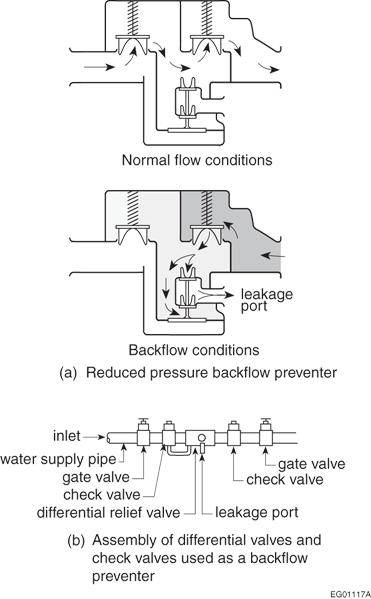
Figure A-1.4.1.2.(1)-A
Backflow preventer
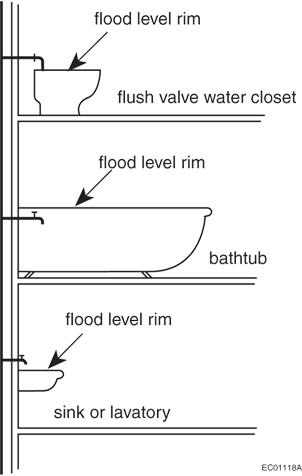
Figure A-1.4.1.2.(1)-B
Back-siphonage
Notes to Figure A-1.4.1.2.(1)-B:
|
|
|
| (1) |
Figure A-1.4.1.2.(1)-B shows a situation that is fairly common in old buildings. If the bathtub is
filled to a level above the faucet outlet, or if the flush valve of the
water closet is faulty, and if the faucet at the sink or lavatory on the
lower floor is opened, water can be drawn (siphoned) from the bathtub or
the water closet into the water system when the pressure in the water
system is low or the water supply has been shut off.
|
| (2) |
Back-siphonage can be prevented in the above situations by
providing an air gap or a back-siphonage preventer (see Subsection 2.6.2. of Division B).
|
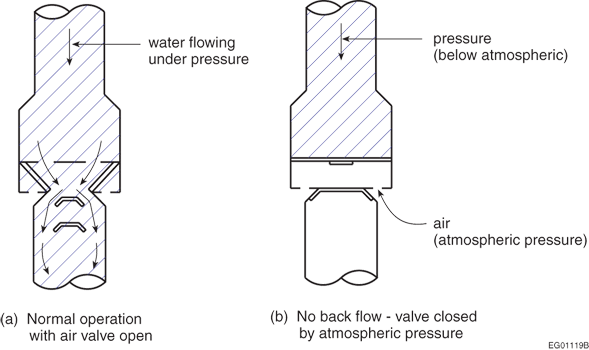
Figure A-1.4.1.2.(1)-C
Back-siphonage preventer
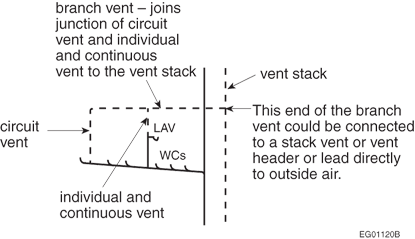
Figure A-1.4.1.2.(1)-D
Branch vent
Notes to Figure A-1.4.1.2.(1)-D:
|
|
|
| (1) |
See also the definitions of header and drainage system in
Article 1.4.1.2. |
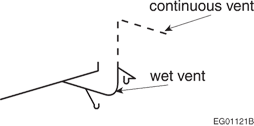
Figure A-1.4.1.2.(1)-E
Continuous vent
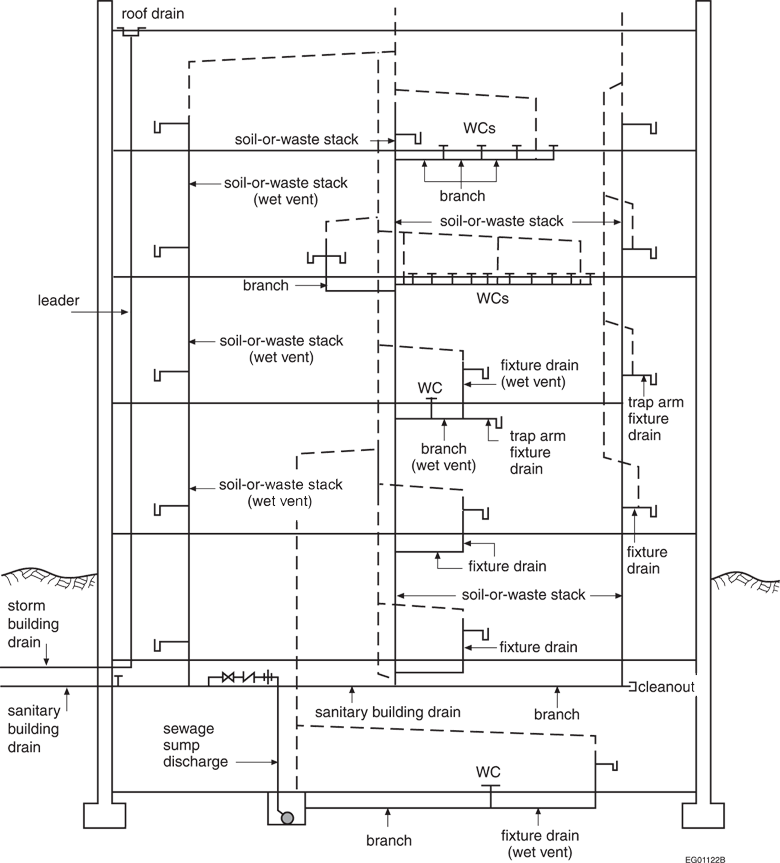
Figure A-1.4.1.2.(1)-F
Drainage System
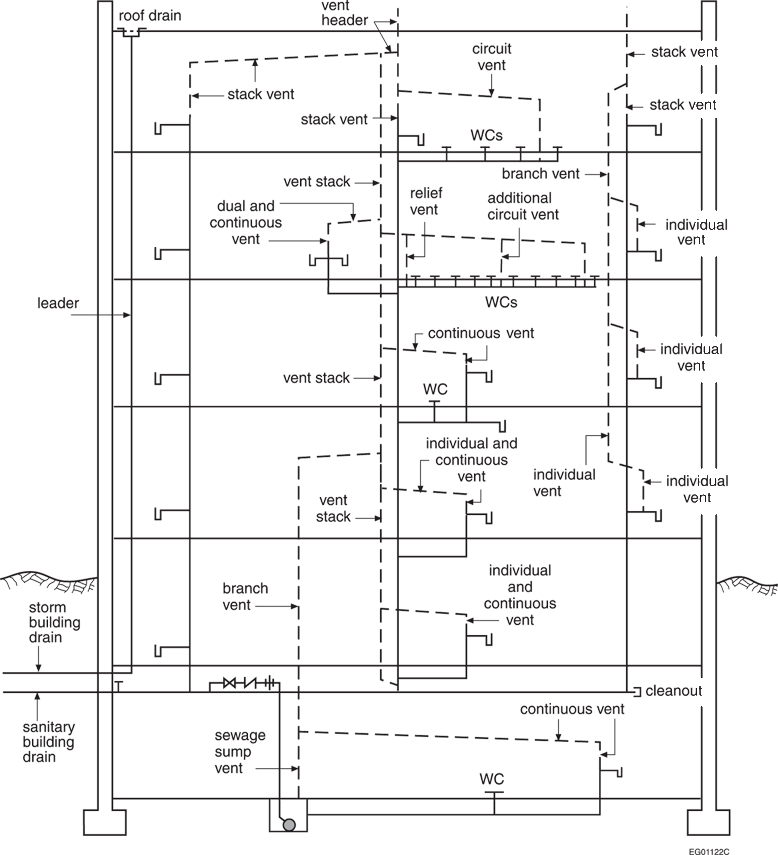
Figure A-1.4.1.2.(1)-G
Venting System
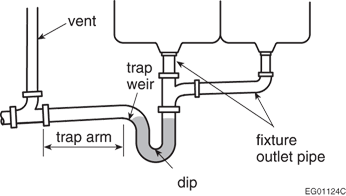
Figure A-1.4.1.2.(1)-H
Fixture Outlet Pipe and Trap Arm
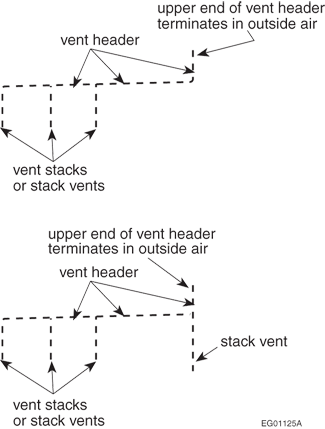
Figure A-1.4.1.2.(1)-I
Vent Header
Notes to Figure A-1.4.1.2.(1)-I:
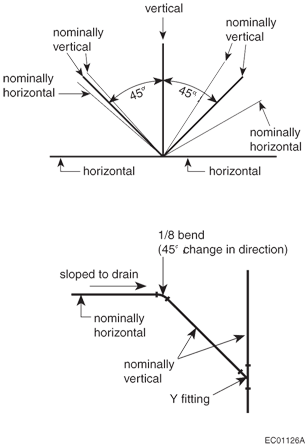
Figure A-1.4.1.2.(1)-J
Nominally Horizontal and Nominally Vertical
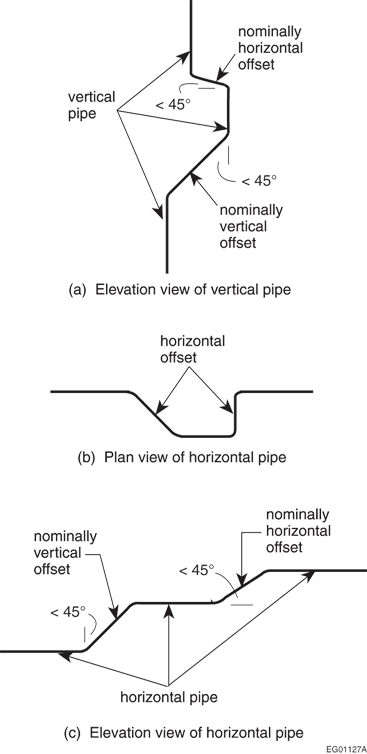
Figure A-1.4.1.2.(1)-K
Offset
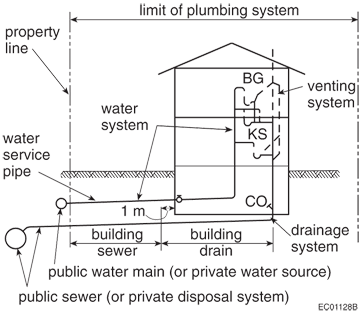
Figure A-1.4.1.2.(1)-L
Plumbing System

A-1.5.1.1.(1) Application of Referenced Documents
Documents referenced in the NPC may contain provisions covering a wide range of
issues, including issues that are unrelated to the objectives and functional
statements stated in Parts 2 and 3 of Division A respectively; e.g. conservation of
water resources. Sentence 1.5.1.1.(1) is intended to make it clear that, whereas referencing a document in the NPC generally has the effect of
making the provisions of that document part of the Code, provisions that are
unrelated to plumbing systems or to the objectives and functional statements
attributed to the provisions in Division B where the document is referenced are
excluded.
Furthermore, many documents referenced in the NPC contain references to other
documents, which may also, in turn, refer to other documents. These secondary and
tertiary referenced documents may contain provisions that are unrelated to plumbing
systems or to the objectives and functional statements of the NPC: such
provisions—no matter how far down the chain of references they occur—are not
included in the intent of Sentence 1.5.1.1.(1) of Division A.
A-2.2.1.1.(1) Objectives
Listing of objectives
Any gaps in the numbering sequence of the objectives are due to the fact that
there is a master list of objectives covering the three principal National Code
Documents—the National Building Code, the National Fire Code and the National
Plumbing Code—but not all objectives are pertinent to all Codes.
The building or facility
Where the term “the building or facility” is used in the wording of the
objectives, it refers to the building or facility for which compliance with the
National Plumbing Code is being assessed.
A-3.2.1.1.(1) Functional Statements
Listing of functional statements
The numbered functional statements are grouped according to functions that deal
with closely related subjects. For example, the first group deals with fire risks,
the second group deals with the structural properties of piping materials, etc.
There may be gaps in the numbering sequence for the following reasons:
- Each group has unused numbers which allows for the possible future creation of additional functional statements within any one group.
- There is a master list of functional statements covering the three principal National Code Documents—the National Building Code, the National Fire Code and the National Plumbing Code—but not all functional statements are pertinent to all Codes.